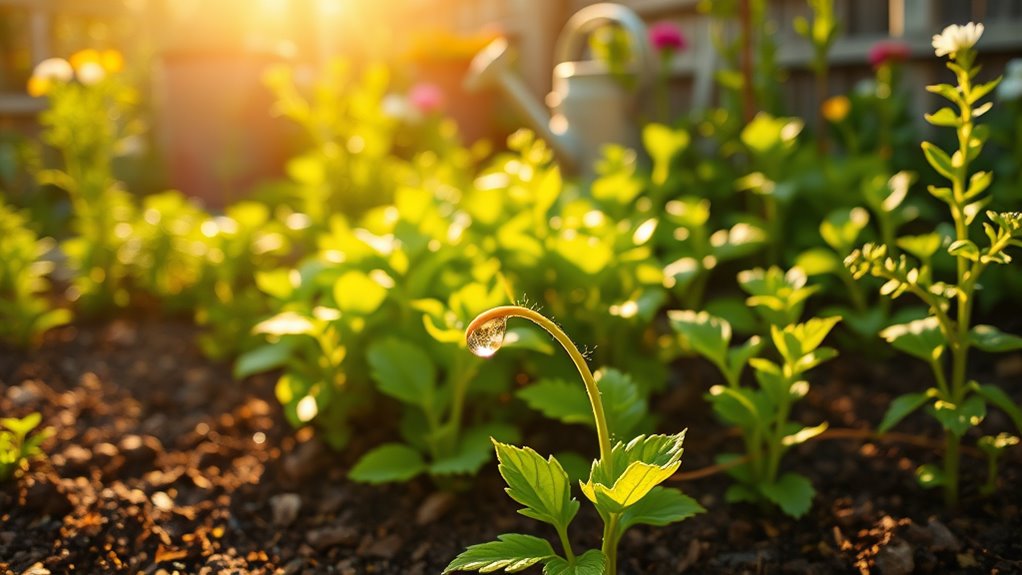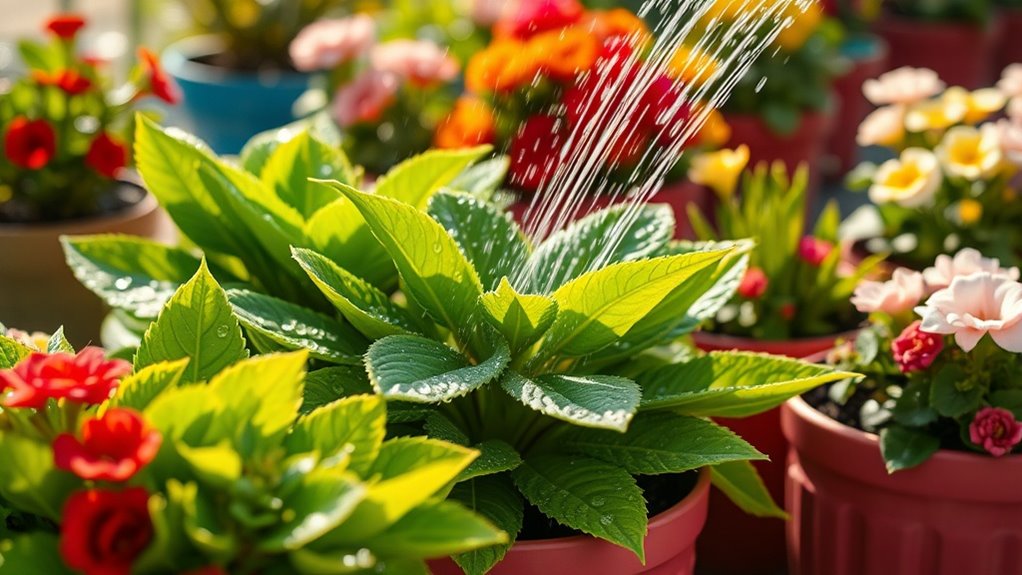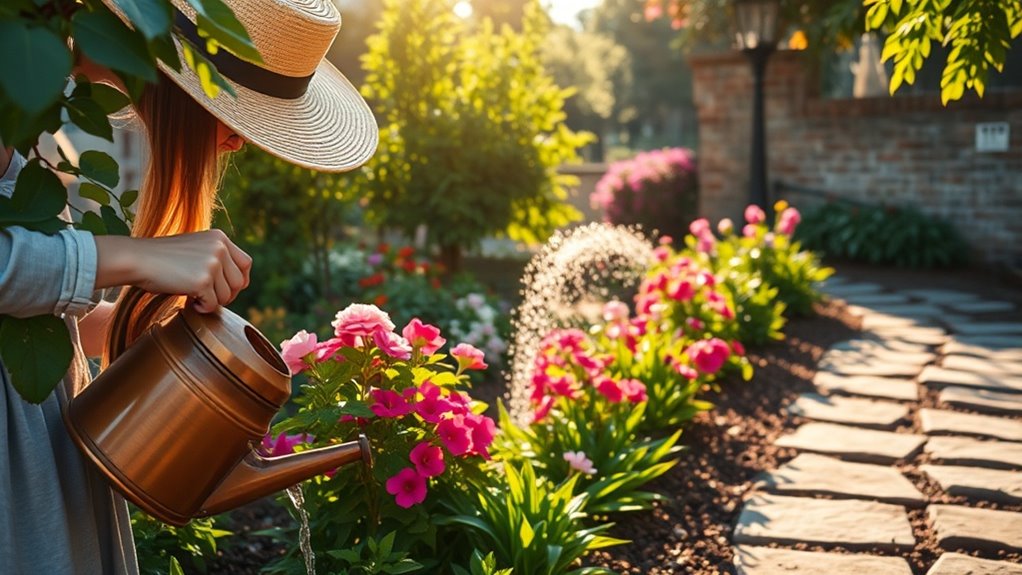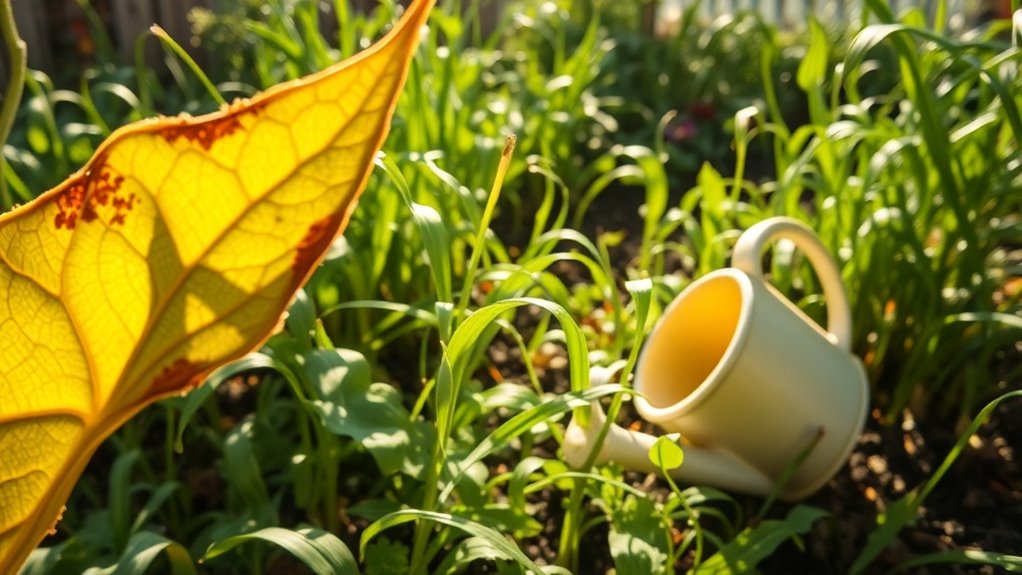Save Water and Still Keep Plants Thriving With These Tips
Did you know that landscaping accounts for nearly 30% of residential water use? This statistic highlights the need for smart strategies to maintain vibrant gardens while conserving water. By selecting the right plants and employing efficient techniques, you can foster a lush environment without excessive irrigation. Explore these practical tips to transform your garden into a sustainable oasis that thrives even in dry conditions.
Key Takeaways
- Implement companion planting to enhance growth and reduce pests, leading to healthier plants that require less water.
- Use organic mulches to retain soil moisture, suppress weeds, and moderate soil temperature for better root protection.
- Water early in the morning or late afternoon to minimize evaporation and ensure plants receive adequate hydration.
- Install drip irrigation systems or soaker hoses for efficient watering directly at the roots, reducing overall water usage.
- Collect rainwater for irrigation to decrease reliance on municipal sources and provide chemical-free hydration to your plants.
Choose Drought-Resistant Plants
When planning your garden, selecting drought-resistant plants can significantly reduce water usage and maintenance.
These hardy species require less frequent watering, enabling you to save water in the garden while still enjoying vibrant blooms and lush foliage.
Native plants, succulents, and various herbs often thrive with minimal irrigation. Beginner-friendly vegetables like tomatoes and peppers can also be great additions to your garden.
By incorporating these plants, you not only conserve water but also create a sustainable ecosystem that supports local wildlife.
Research the specific needs of each plant to ensure compatibility with your garden’s conditions.
Ultimately, choosing drought-resistant options leads to a low-maintenance, eco-friendly garden that flourishes with less effort on your part.
Implement Mulching Techniques
Implementing mulching techniques can significantly enhance your garden’s water retention and reduce weed growth.
By understanding the benefits of different types of mulch, you can make informed choices that support your plants’ health. Additionally, using organic mulch can improve soil structure and increase moisture retention in your garden. Let’s explore how to effectively use mulch to conserve water and improve soil quality.
Benefits of Mulching
Mulching offers several significant benefits for your plants and garden as a whole.
By applying a layer of mulch, you effectively retain soil moisture, reducing the need for frequent watering. This helps prevent weeds from sprouting, minimizing competition for nutrients and water.
Additionally, mulch moderates soil temperature, protecting roots during extreme weather.
It also promotes healthy soil structure by gradually breaking down and enriching the soil with organic matter.
Moreover, mulching can prevent soil erosion, ensuring stability for your plants.
Types of Mulch
Choosing the right type of mulch can significantly impact your garden’s health and water conservation efforts.
Organic mulches, like wood chips or straw, improve soil structure as they decompose, enhancing moisture retention.
In contrast, inorganic options, such as gravel or landscape fabric, provide long-lasting barriers against weeds and help regulate soil temperature.
Consider your garden’s specific needs; for example, if you’re growing vegetables, opt for organic materials that enrich the soil.
For ornamental beds, inorganic mulch may suit your aesthetic preferences.
Ultimately, selecting the appropriate mulch type is crucial for optimizing water use while keeping your plants thriving.
Optimize Watering Schedule
To optimize your watering schedule, consider the best time of day to water, as early morning is typically ideal. Monitoring soil moisture levels helps you determine when your plants actually need water, preventing over or under-watering. Additionally, understanding each plant’s specific watering needs will ensure you provide the right amount at the right time. Implementing proper watering techniques can also enhance the efficiency of your watering routine.
Watering Time of Day
When’s the best time to water your plants?
Timing can significantly impact water efficiency and plant health.
Here are three optimal times to consider:
- Early Morning: Watering before 10 AM minimizes evaporation and allows plants to absorb moisture throughout the day.
- Late Afternoon: If mornings aren’t feasible, aim for late afternoon. This timing prevents high midday temperatures from wasting water.
- Evening: Watering in the evening can be effective but avoid it if humidity is high, as it may promote fungal diseases.
Soil Moisture Monitoring
While understanding your plants’ watering needs is crucial, monitoring soil moisture is even more essential for optimizing your watering schedule.
By regularly checking the soil’s moisture level, you can determine when to water, preventing over or under-watering.
Use a moisture meter for precise readings, or stick your finger into the soil up to two inches.
If it feels dry, it’s time to water; if it’s still moist, wait.
This approach not only conserves water but also promotes healthy root development.
Adjust your watering frequency based on seasonal changes and plant growth stages to ensure your plants thrive while saving water.
Plant Watering Needs
Understanding your plants’ watering needs is vital for maintaining their health and conserving water.
To optimize your watering schedule, consider the following:
-
Know Your Plants: Different species have varying water requirements. Research your specific plants to understand their needs.
-
Check the Soil: Before watering, check the top inch of soil. If it’s dry, it’s time to water; if it’s still moist, wait a bit longer.
-
Water Early or Late: Water your plants in the early morning or late evening. This reduces evaporation and allows for better absorption.
Utilize Rainwater Harvesting
Rainwater harvesting offers a sustainable solution to conserve water for your plants, especially in regions facing water scarcity.
By collecting rainwater from roofs or other surfaces, you can reduce your reliance on municipal water sources.
First, set up a collection system using barrels or cisterns; ensure they’re covered to prevent mosquito breeding.
Regularly maintain your system to keep it clean and functional.
You can use this harvested water for watering your garden, reducing costs and easing the strain on local water supplies.
Plus, rainwater is often free of chemicals, providing your plants with pure hydration for optimal growth. Additionally, incorporating effective collection methods can greatly enhance your rainwater harvesting efforts.
Apply Efficient Irrigation Systems
Implementing efficient irrigation systems can significantly enhance your water conservation efforts.
By choosing the right system for your garden, you’ll minimize waste and promote healthy plant growth.
Consider these options:
-
Drip Irrigation: Delivers water directly to the plant roots, reducing evaporation and runoff.
-
Soaker Hoses: Allow water to seep through porous material, providing consistent moisture to the soil.
-
Smart Timers: Automate watering schedules based on weather conditions and moisture levels, ensuring optimal irrigation.
Additionally, understanding ideal watering schedules can help you determine the best times to irrigate your plants for maximum effectiveness.
Monitor Soil Moisture Levels
Keep your plants thriving by monitoring soil moisture levels regularly. Understanding when to water is crucial for plant health and water conservation.
Use a moisture meter or simply check the soil with your finger; the top inch should feel dry before you water again.
Overwatering can lead to root rot, while underwatering stresses your plants. Be aware of the signs of overwatering in your plants, such as yellowing leaves and wilting.
Aim for consistent moisture, adjusting based on weather conditions and plant needs.
Remember that different plants have varying moisture requirements, so tailor your approach accordingly.
Practice Companion Planting
Companion planting offers a strategic approach to maximizing your garden’s efficiency and health.
By carefully selecting plant pairings, you can enhance growth, reduce pests, and conserve water.
Here are three benefits of companion planting:
- Pest Control: Certain plants repel pests, minimizing the need for chemical pesticides.
- Nutrient Sharing: Some plants, like legumes, improve soil quality, benefiting their neighbors.
- Microclimate Creation: Taller plants provide shade, reducing evaporation and keeping moisture levels consistent.
Additionally, companion planting with tomatoes and peppers can lead to a thriving garden while saving precious water resources.
Be intentional about your plant choices for optimal results.





